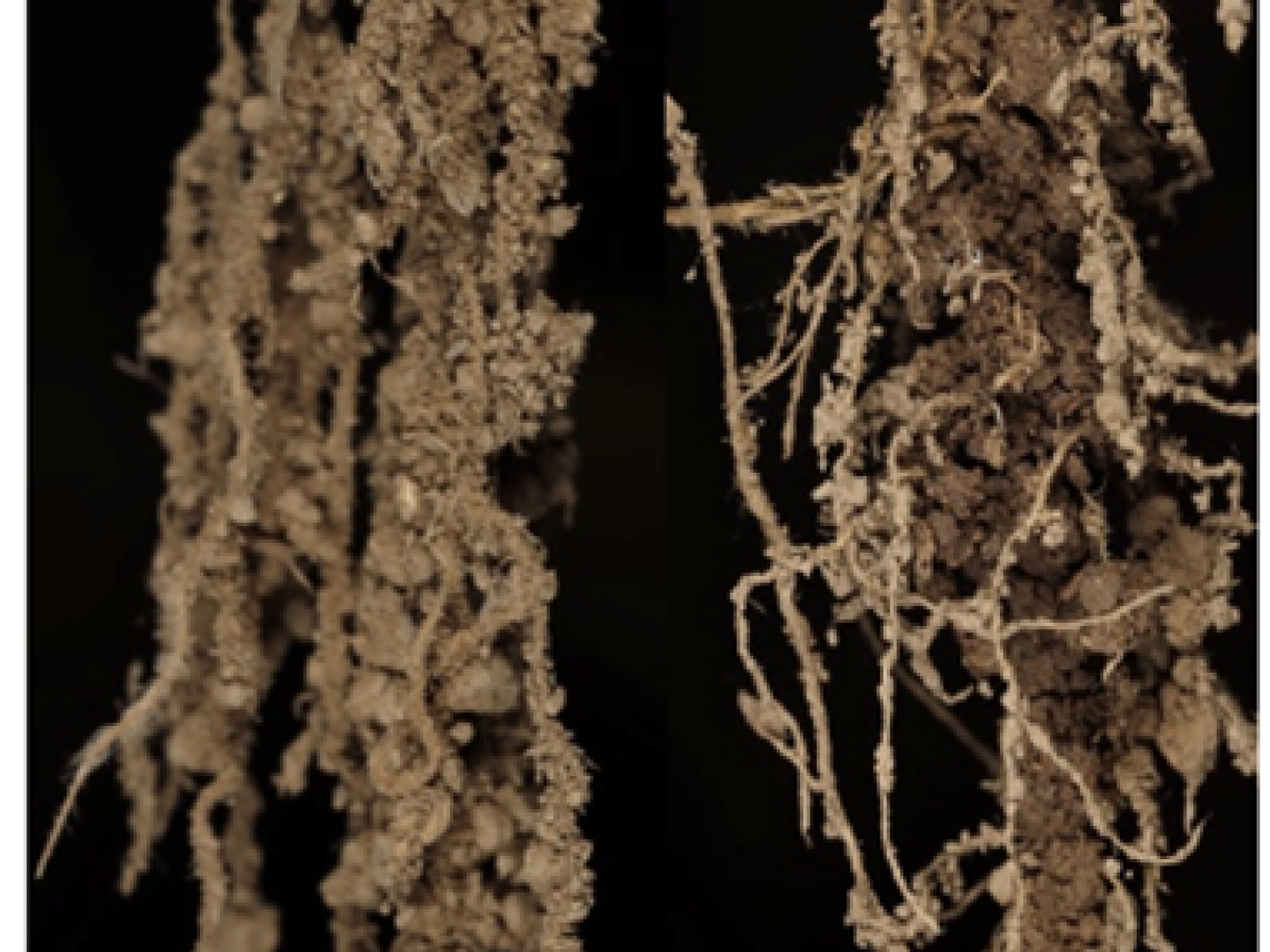No “One Ring to Rule Them All”: Different Microbial Traits Influence Soil Carbon Accrual from Living Versus Dead Roots
The microbial traits that shape mineral-associated soil carbon formation are not universal but vary in different soil microbial habitats

A photo displays rhizosphere soil under normal moisture (left) and drought conditions (right).
(Image by Michael Eisen | University of California, Berkeley)
The Science
Soil microorganisms are frontline managers of the terrestrial carbon cycle. They shape the formation and decomposition of soil organic carbon (SOC)—Earth’s largest terrestrial carbon pool—by transforming plant inputs into soil carbon. Because soil microbes are central to the global carbon cycle, a major research priority is to identify which microbial traits are most important for soil carbon cycling and to include these traits into biogeochemical models that help predict climate change. To date, most research on microbial traits has assumed that a key set of universal traits should be linked with soil carbon, such as how fast the microbial community grows or how efficiently soil microorganisms assimilate carbon from plants. However, soils are not homogenous, but contain distinct microbial habitats, including the regions surrounding living and dead roots. These habitats host very different microbial communities, with different species compositions and traits. A multi-institutional team of researchers investigated whether different microbial communities within different habitats expressed unique sets of traits that influenced mineral-associated soil carbon formation.
The Impact
Soils contain the largest actively cycling pool of organic carbon on the planet. The dynamics that shape the formation and decomposition of this carbon pool help regulate Earth’s climate. Soil microbes are key gatekeepers of this soil carbon pool—particularly mineral-associated soil carbon, the largest and slowest-cycling fraction of organic carbon belowground. Here, research shows that the microbial traits which shape the accrual of mineral-associated organic carbon are not universal, but vary within two key microbial habitats in soil where mineral-associated soil carbon is formed. These include the region around living roots (the rhizosphere) and decaying roots (the detritusphere). The team’s findings have key implications for biogeochemical models because modelers increasingly aim to include activities of soil microbes into biogeochemical models (known as “microbially explicit” models) for improved predictions of climate change. The team’s results suggest there is not a single set of traits that predict soil carbon accrual—there’s no “one ring to rule them all”—but rather, there are different traits that are important in different regions of soil where mineral-associated carbon is formed.
Summary
A multi-institutional team of researchers conducted a 13C-labeling greenhouse study using a semi-arid grassland soil, where they tracked the fate of 13C-labeled inputs from living roots and decaying roots from the annual grass Avena barbata under different moisture conditions. By capturing the movement of these two 13C-root inputs into the different microbial habitats where they enter the soil—the rhizosphere (the soil directly around living roots) and the detritusphere (the soil around decaying roots)—they were able to ask which microbial traits were related to soil carbon accrual. The team found important differences in which microbial traits were linked with 13C-mineral-associated SOC within these two soil habitats. In the rhizosphere, they found that bacterial-dominated communities with fast growth, high biomass, and high extracellular polymeric substance production were positively associated with 13C-mineral-associated SOC. In contrast, the detritusphere held communities dominated by fungi and more filamentous bacteria with greater exoenzyme production. There, 13C-mineral-associated SOC was associated with slower microbial growth and lower microbial biomass. The team also examined which specific taxa were assimilating 13C by using the technique “13C-quantitative stable isotope probing.” Interestingly, they found that the majority of 13C assimilation in the rhizosphere and detritusphere was performed by relatively few bacterial and fungal taxa—only 3–5% of the total taxa that assimilated 13C. The team’s findings help advance understanding of soil carbon cycling by demonstrating that microbial traits linked with mineral-associated SOC are not universal, but vary with soil habitat and moisture conditions and are shaped by a small number of active taxa.
Contacts
Noah Sokol, Lawrence Livermore National Laboratory, sokol1@llnl.gov
Jennifer Pett-Ridge, Lawrence Livermore National Laboratory, pettridge2@llnl.gov
Ljiljana Pasa-Tolic, Environmental Molecular Sciences Laboratory, Ljiljana.PasaTolic@pnnl.gov
Funding
This research was supported by the Department of Energy (DOE), Biological and Environmental Research program, Genomic Science Program "Microbes Persist" Scientific Focus Area at Lawrence Livermore National Laboratory (LLNL) and subcontracts to Northern Arizona University, Lawrence Berkeley National Laboratory, Pacific Northwest National Laboratory (PNNL), and the University of California, Berkeley. Work at LLNL was conducted under the auspices of DOE. Work was performed at the Environmental Molecular Sciences Laboratory, a DOE Office of Science user facility sponsored by the Biological and Environmental Research program. EMSL is located on the campus of PNNL.
Published: July 22, 2024
N.W. Sokol, M.M. Foley, S.J. Blazewicz, A. Bhattacharyya, N. DiDonato, K. Estera-Molina, M. Firestone, A. Greenlon, B.A. Hungate, J. Kimbrel, J. Liquet, M. Lafler, M. Marple, P.S. Nico, L. Paša-Tolić, E. Slessarev, J. Pett-Ridge. 2024. “The path from root input to mineral-associated soil carbon is dictated by habitat-specific microbial traits and soil moisture.” Soil Biology and Biochemistry 193, 109367. DOI: 10.1016/j.soilbio.2024.109367